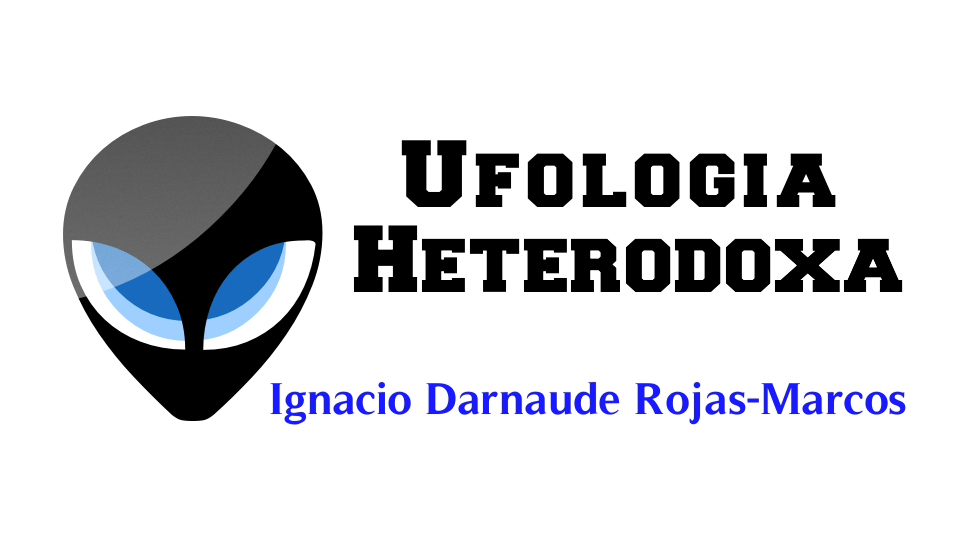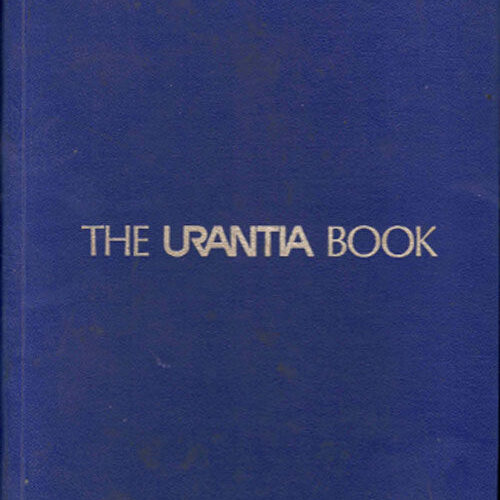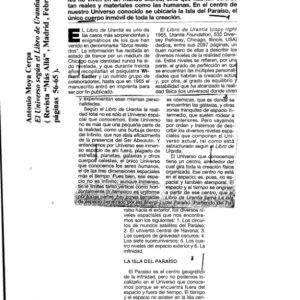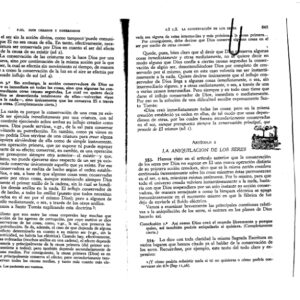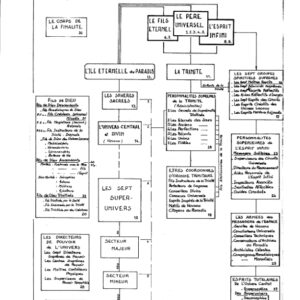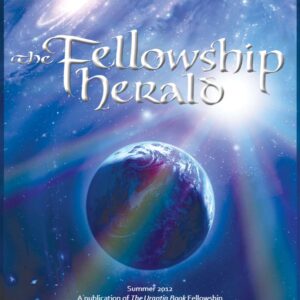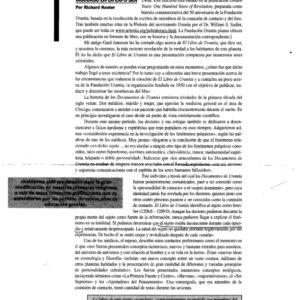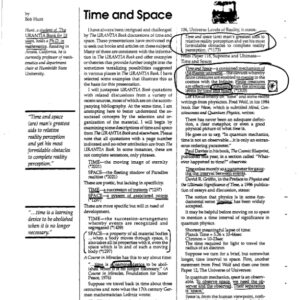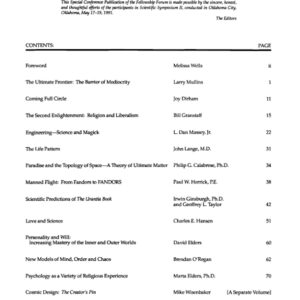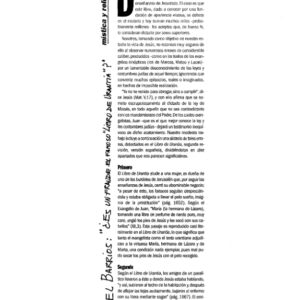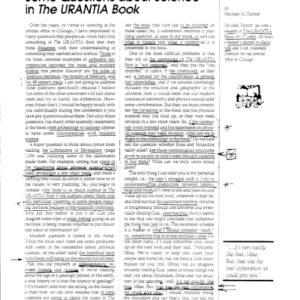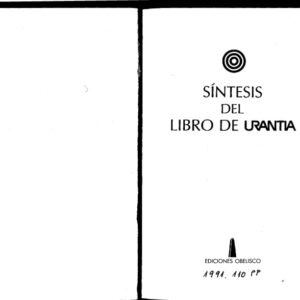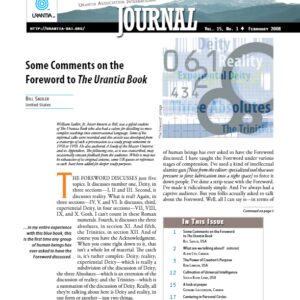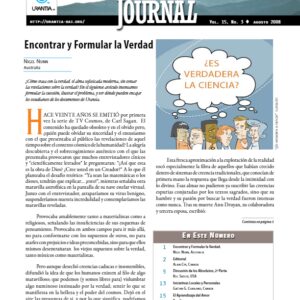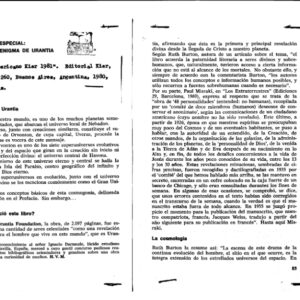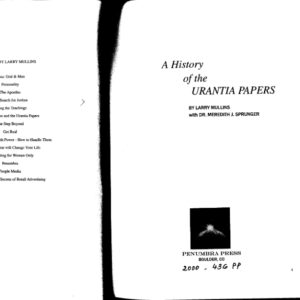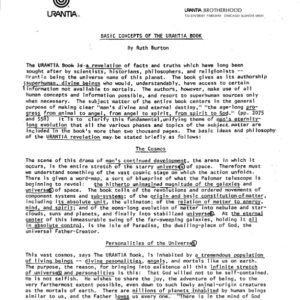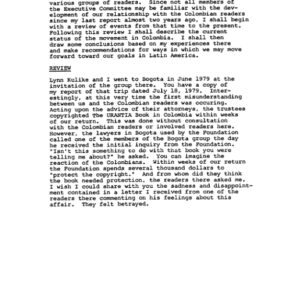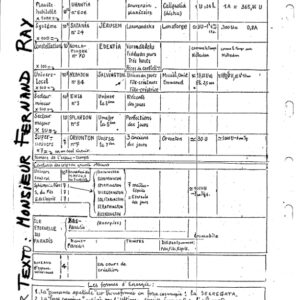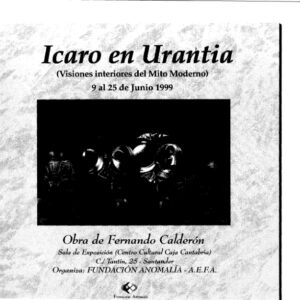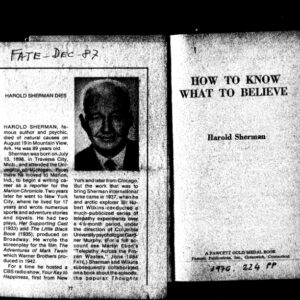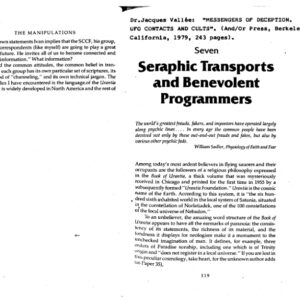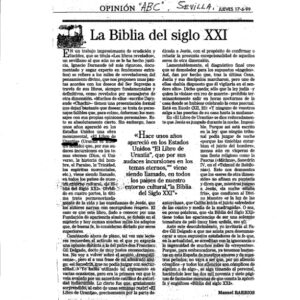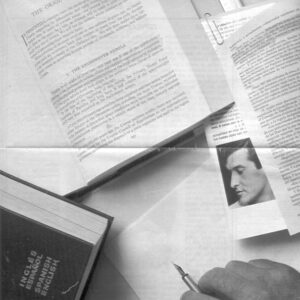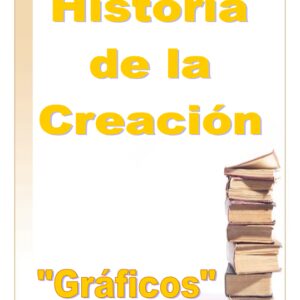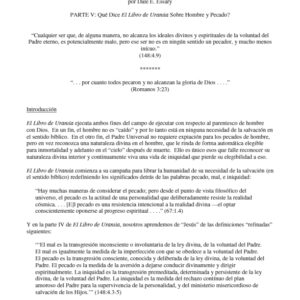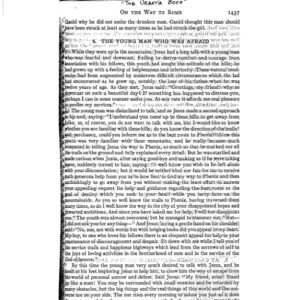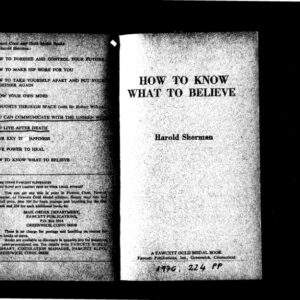Urantia book history 2
- Descripción
Descripción
Urantia book history 2
Gardner, Moyer, and Mullins:
Three Histories of the Urantia Book
By Matthew Rapaport
At the opening of the 21st century we find ourselves with 3 large histories of the Urantia Papers. First published, URANTIA: The Great Cult Mystery by Martin Gardner in 1995, followed by Ernest Moyer’s THE BIRTH OF A DIVINE REVELATION: The Origin of the Urantia Papers, and then A History of the Urantia Papers by Larry Mullins, both published in 2000.
From a believer’s perspective, Larry Mullins’ story of the revelation is the most orthodox with all the phases through which the papers traveled overseen – however infrequently – by divine authority until the actual year of first printing in 1955. While this is, essentially, the down the middle story, it is full of interesting suprises and well clarifies some of the conflicting aspects of even the official histories as they’ve been recorded since the first printing. It is also the most severely critical of the present status quo in the Urantia Movement.
Martin Gardner’s book, while often funny – and you better have a sense of humor about yourself because he’s poking fun at us – is so interlaced with misinterpretations, out of context statements, even outright lies and slander “Below I AM are billions of lesser gods” Gardner declares on p19, that his insightful observations may be too easily dismissed by UB readers. Gardner paints a picture of utterly human invention, deceit, and betrayal that explains the existence of the UB. He selects out-of-context events of UB history, especially those surrounding Harold Sherman and Harry Loose, that best suit his purpose, and then weaves a story around these isolated facts.
In between this telling, he does manage to make some interesting observations however, and it is a shame that the insights are mixed in with so much that is misrepresentative. Gardner’s only concession to the divinity of the revelatory process is the acknowledgement that there was a sleeping subject, and that this person (he thinks its Wilfred Kellog) made statements and/or wrote things whose content is part of that which makes up the UB. He does not share any opinion on whether this material really had a celestial origin, or was merely the product of the sleeping subject’s mind. For Gardner, the UB comes down to some unexpected (and unexplained) channeling on the part of Wilfred Kellog coupled with a conspiracy, on the part of Dr. Sadler, to inject into the spiritual ferment and literary stream of his time, a fantastic fraud. The saddest irony of Gardner’s book is that if he had employed the services of a UB reader merely to delete the out rightly false statements concerning the UB’s contents (I know he had offers), what would be left would still be pretty damning.
Ernest Moyer, like Larry, believes that at core, the UB is divinely authored. Moyer however looks at the unfolding events of the late thirties and early forties and forces us to ask the question: What is the deposed Planetary Prince (whom we all suppose for the sake of argument is still on the planet) doing about the UB? We all take for granted that he (Caligastia) would desire to obstruct or otherwise thwart the fundamental purposes of the UB. We differ in our estimation of just how much potency he has in this regard, with Moyer casting his history in the light of his presupposition of Caligastia’s ability to enter into and dialog with any human mind who sits back and says “come hither spirit and talk to me.” Ironically, for his version of things, Caligastia’s worst couldn’t have been more damaging than what the movement, particularly the Urantia Foundation, has done to itself! If old Cal was involved, it wasn’t the text that appears to have been his target, as much as the movement.
Larry Mullins manages to deal well with both Gardner and Moyer, but only if you accept some of his central propositions to be fundamentally factual. Mullins claims that no communication with celestials ever took place without the presence of the sleeping subject and at least two of the human contact commissioners. If his claims are correct, then it would have been impossible for either Christy or Dr. Sadler to have believed that the celestial revelatory commission could be reached by channeling, let alone that Dr. Sadler would have taken channeled messages as the product of celestial intelligences. Mullins addresses other of Moyer’s evidence as well, pointing out for example that the Book’s 1934, 35 “indictment” statements mean only that the sections were begun in those years, not that they were a finished product.
Most people in the Urantia movement take for granted that a small amount of human error began to filter into the revealed material as soon as the original handwritten papers were typed. Further minor errors were introduced during the typesetting process, unnoticed by the proofreaders. The original set of nickle-plated stereotypes thus contained errors, which appeared in the first printing of the Urantia Book. Everything that went before the plates – the handwritten pages, the typed manuscripts, etc. – was destroyed. At that point, the plates became the canonical Urantia Book.
Imperfections were supposed to distance the Urantia Book from anything that might appear supernatural or unduly extraordinary. They were, I’d supposed, mostly typographical in nature, with a few typos making some semantic difference. I had also learned that alterations were made to the text between the various printings and that some of them went beyond the correction of obvious typos. This was not of great concern to those of us who noticed these things as the number of these semantic modifications was very small (fifteen, according to Mullins), and could easily be analyzed and evaluated by an enlightened readership. Mullins observes, however, that dispite revelator involvement through 1955, they apparently never mention these imperfections. This fact fits nicely with Gardner’s version of events.
Gardner attacks UB content on scientific grounds, on its uncanny similarities to some Seventh Day Adventist doctrine (in which W. S. Sr. was heavily involved in his earlier days), and upon it’s over all theological silliness. His theological criticisms are unfounded. He misunderstands the theology of the UB, and likely got much of it second hand. He notes for example that the UB’s concept of God The Supreme is reflected in the early 20th century theology of Teilhard de Chardin, but utterly misses the fact that Teilhard thinks he’s discovered the whole of God while the UB places the Supreme in a context much wider than anything Teilhard imagined.
The parallelisms Gardner identifies between the doctrines of Seventh-day Adventism (as expressed in the writings of Ellen G. White, one of the sect’s founders) and some of the teachings of the Urantia Book, are intriguing. Also interesting are the connections he draws between the UB’s teachings and some of Dr. Sadler’s philosophic beliefs and scientific views, as expressed in Sadler’s early books. Gardner suggests that Sadler must have felt betrayed when he discovered, in about 1906, that the supposedly prophetic revelations of Ellen White were often little more than plagiarisms of other human writers. Stung by this sense of betrayal, Sadler decided to create a new religion, adopting not only material from Seventh-day Adventism but White’s plagiaristic methods as well.
In this case, Gardner’s criticism finds a ready answer in the canon of UB thought. Revelation is not entirely new, but expresses itself largely from what exists. The Seventh Day Adventist connection could, after all, be one of the reasons W. Sadler Sr. was chosen by celestials for the task! Gardner notes however, the number of coincidental agreements with Dr. Sadler’s other writing is very large on subjects as diverse as eugenics and humor. Gardner wants us to conclude that the UB was largely written by Sadler. Gardner, however, is at a loss to explain how the language of the UB, while reflecting Sadler’s own work, also makes distinctions and qualifications that Sadler’s thought lacks. Gardner does not notice that revelation is not utterly new. It borrows from the past, and filters it. Why shouldn’t Ellen White’s recognition of “soul sleep” happen to be a genuine insight?
Gardner’s criticisms of the science of the Urantia Book are very telling. He does a service to the Urantia movement by highlighting the «timebound» or erroneous data sprinkled through the first three Parts of the UB. He makes it clear that much of the UB’s science reflects the views, and is expressed in the style, of popular 1920’s scientific and semi-scientific literature. He also finds the UB’s political philosophy dated, characterizing the book’s call for world government as simply an echo of views advocated by U.S. President Woodrow Wilson. It never occurs to Gardner that a world government of the kind the described in the UB makes sense regardless of its historical associations.
One begins to wonder, though, about the amount of timebound or erroneous information in the Urantia Book, and whether all of its material should be taken literally. Were Adam and Eve real people? Were they in fact «biologic uplifters» from Jerusem, or are they mythical characters created by the revelators in an attempt to foster a «creation myth» suitable for the early to mid 20th century. Gardner sees echoes of the Adam and Eve story in Sadler’s view of genetics and eugenics. They would be Dr. Sadler’s “creation myth”.
Moyer thinks that the more significant erroneous time bound data is the work of Caligastia via the channeling Christy, his attempt to corrupt the revelation. Indeed no one seems precisely to know just how many changes took place during this critical years from 1935 to 1942, the period on which Moyer focuses his attention. Moyer, and Mullins, based on Sadler’s off handed remarks concerning them, take these changes to be relatively few in number. Gardner, on the other hand, paints a picture of broad discrepancy between the UB and modern science. In the opinions of this reviewer, some of his criticisms are legitimate while others are not. Moyer believes that Caligastia began influencing events through a channeling Christy in 1939. He grants (in personal conversation) that since she was personally responsible for small changes to the UB between the first two printings, and even up to her death in 1982, Caligastia would still have possessed a channel into the Urantia Foundation at least until that date.
Moyer alludes to events and policies that punctuate the history of the Urantia Movement since 1955. Gardner, not surprisingly, portrays this history as nothing but a parade of silliness and gullibility based upon a colossal fiction. It is left to Mullins to provide us with the most detailed and helpful analysis of everything that had happened in the history of the UB and the movement that surrounds it.
From the autocratic structure of the Book’s controlling body, unpopular with some as far back as the 1930’s, to textual changes unknown and unapproved by more than one of the original members of the Urantia Foundation, Mullins builds a case for the Urantia Foundation’s legal and moral default of its own declaration of trust. He also elaborates on the significance of the elite circle within the elite group that became the Urantia Foundation. Three of the original members of the Foundation were also contact commissioners, those involved directly in the receipt of the revelation. This gave them, and Emma Christensen in particular, a special status that has had its continuing impact to the present day.
Gardner does not understand Christy’s significance to the whole UB story. Moyer and Mullins well understand it, and both point a finger firmly at her as the focal point of much of what has occurred in the Urantia Movement even after her death. Christy believed that she received communications from midwayers (presumably) and/or other members of the celestial planetary government. Other prominent persons in the movement (including the other two contact commissioner Trustees) since 1955 and up to her death also believed this, or at least accepted the claim as a means of justifying policy. Moyer believes this process began in 1939 after the death of Lena Sadler. If Larry is correct about the sleeping subject mechanism being in place at every instance of communication until 1955, this would have been impossible.
What happened after the last 1955 contact was made however is another matter. Both Moyer and Mullins note that changes to the text between the first two printings were primarily Christy’s responsibility. Larry notes carefully that the change process, and the belief (on the part of some members of the UF) that Christy had a “special relation to the text” and continued if infrequent contact with celestials, is a critical component in their default as a body, but more importantly continues to have consequences for our present situation. Mullins’ patient examination of the mechanisms of the real – pre 1955 – contacts cast serious doubt on the veracity of any of these contact claims.
Too bad no body thought to examine these matters in the early 1960s! Christy’s stature brought both Martin Myers and Vern Grimsley into prominence. She saw something she liked in both young men, and invested them with early authority in the movement thanks to her continued relationship to celestials. Myers subsequently grew to become the goliath of the Urantia Foundation slaying creative initiative in the use and distribution of the content of the UB on the part of reader-believers with ceaseless litigation. No one more than he, a believer in Christy’s messages, was responsible for the schism that still rends the Urantia Movement today, while Vern Grimsley picked up the mantle of Christy’s contact with celestials itself!
Less than a year after Christy died, Vern was contacted by the midwayers! What followed that episode sent Urantian’s all over the U.S. literally and figuratively packing for the hills. The events that occured between that date and dissolution of The Family Of God Foundation (FOG), Vern’s organization, in March of 1984 changed the Urantia Movement forever. Ironically, Myers recognized that his fraternity brother was deluded and stood fast against the early pull to consolidate power in Grimsley’s hands. In a double irony, the disaffected members of FOG still retained a measure of power and respect in the Urantia Movement, and ended up among the strongest opponents of the policies of Martin Myers with whom they had, until the time of Grimsley’s contact, been allies!
Based on Mullins work, one might go as far as to say that even if the UB is certifiably divine, the entire history of the Urantia Movement since the first printing of the book has been, and continues to be, based on a tissue of lies and false belief starting with Christy’s continued contact with celestials! Even this notion continues to find expression throughout the Urantia Movement! Like the “religion about Jesus” begun on that fateful day of Pentecost by Peter, The notion of contact with celestials is a very powerful draw. In the early 1990’s, after languishing for half a decade following the WWIII episode, not one, but numerous people came forth claiming to have been contacted. A whole new “phase of the revelation” was manifesting before our eyes (one way or another I’m afraid), and now, anyone could be contacted who desired it!
To Larry, this newest twist is yet another divisive event possibly fostered by the Urantia Foundation’s open declaration of their belief in the channeling activities of Christy: “We have reason to believe that none of the changes were made without the approval of the Revelators” they declare. Why shouldn’t celestials be talking to all of us? For Ernest, the present channeling wave is yet another channel of involvement by Caligastia who can disguise himself as anything and talk to anyone who simply declares him or herself open to chat! Lastly for Martin Gardner, it’s just another cycle in the silliness of UB readers proving only once again that some people will believe anything!
Postscript
As I was working on this review, another watershed event occurred in the history of The Urantia Book, and the movement. Both Martin Gardner and Larry Mullins touch on the subject of the Urantia Foundation’s litigious nature, a pattern solidified by Martin Myers, and based on a continuing Foundation claim to owning a copyright on the UB. Their original copyright expired in the early 1980’s, but they renewed it based, on a manifestly false claim, the UB was a “work for hire.”
Since that time, numerous Urantia Book readers have stepped forth in one way or another to challenge the Urantia Foundation’s right to a renewed copyright. The Foundation has predictably and consistently acted to protect its copyright claim by litigation, a process that has wasted millions of dollars and polarized the movement far more than even the recent spate of channeling. Gardner notes all of this infighting and suggests that it is still more evidence of the manifestly human origins of the book. Mullins more correctly recognizes that it is a reflection of the Book’s power; that many groups, some with conflicting claims, seek to attach themselves to it. Although Moyer doesn’t address these issues, he might justifiably note that all of the infighting that has gone on around this issue for the past 25 years might be in Caligastia’s interest.
The Urantia Foundation briefly lost its copyright in the mid 1990’s, but a judge’s order was overturned by another judge after a brief hiatus in the public domain. Now, in June of 2001, a jury in Oklahoma has now decided that the copyright renewal was invalid and The Urantia Book is once again in the public domain, this time, more securely (presumably) than it was before, though the Foundation has, of course, said it will appeal. This certainly presages a new era in the history of the Book. We can look forward to alternate printings in a variety of formats that may appeal to a wider audience. Whether this results in some resurgence of interest in the Book is difficult to predict. As in times past, we seem to take for granted that many people will be interested in this “pearl of great value”, but time and time again, our visions do not appear to materialize.
At least one of the missing ingredients has been the armies of dedicated believers whose lives are changed by contact with the UB and who subsequently share those changes with others. For decades those opposed to the copyright have argued that this continuing claim (and of course the litigation that follows from it) has acted to suppress the growth of private and public ministries that will elevate the Book into the religious consciousness of the Earth’s people. If this was a suppressive influence, it is now mostly gone. It remains to be seen if its absence makes a significant difference.
Matthew Rapaport
